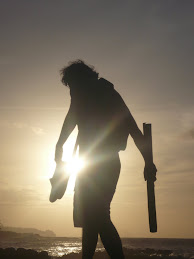Theme Song for the day: 'Money', by PInk Floyd.
Photo:Regenerative Business is...
Today we played a game called: 'Let's Lend Money to Matt.
But first, the morning was spent in lecture-format, to lay a foundational understanding of the Principles of Regenerative Business:
1. Only buy Assets which regenerate themselves.
Photo: Petrol pumps are perceived as a high-value asset, however are costly to run and maintain. A pump powered by renewable energy (such as a solar or RAM pump) would be examples of regenerative assets.
2. Business is a Team Sport.
Photo:Creating support systems for your business increases your available resources to tackle challenges and capitalize upon opportunities. 3. Invest Profits into your Community.
Students were then asked to pretend they were a bank, and I was a customer seeking a small loan from them to start a business. Their bank (and the loan they would give me, if they decided I was qualified candidate) was based on their pooled savings, and so what kind of questions did they have for me?
- What kind of business? (I'm gonna sell tour packages of Bayan Ulgii Province)
- What is your business plan? (I'm gonna sell a lotta tour packages!)
- Where will your business be located? (Above the pub, of course. For networking and public relations purposes. Of course.)
- Show us your SWOT! (...as in Strengths-Weaknesses-Opportunities-Threats-Analysis).
- Have you sought permission from the authorities? (Yes, of course...) ...Prove it.
- How much money will you make? (One MILLion Dollarrrrsss!!.....(in your best 'Dr. Evil' voice))
- How much money are you making right now? (Ummmmm..... not so much?)
- Well then what can you give us for security? (Well... I have this eagle ring you might like....??)
The game was presented farcically, and students had a lot of fun interrogating their poor Instructor (who just wanted a small loan of 1,000,000 MNT (approx $10,000 USD), after all!), coming up with the novel idea of requiring me to marry a local suitor (named Gugan, remember her from the design briefs?) of their choosing in order to ensure i) that profits would be cycled back into the local community, and ii) that she would sort me out if profits were not cycled back into the community (Mongol-Kazakh women are very strong). Quick learners, and crafty dealmakers too!
The entire exercise was designed to give students an interactive lesson to utilize the principles discussed in the morning sessions, to demonstrate how to teach financial literacy with an engaging experience, and -to see if I could actually get them to lend me the money- to facilitate the process of forming individuals into a Self-Help-Group (SHG), which will form the basis of the project's microfinance initiative. Studies of sustainable SHGs in India indicate that groups which are savings-based (ie lend their own money) are more likely to succeed and flourish(i).
Beneficiaries will form informal support groups based on needs, proximity to each other, and personalities - especially as so much infrastructure (root cellar + passive solar greenhouse + drip irrigation system) will be built over the summer of the first year. Learning curves will be steep in the first two years (training will be mostly hands-on, learning by doing, while in winter months theoretical 'debrief' lessons can be facilitated), and beneficiaries can accelerate their learning by sharing information, lessons learned, and resources.
Only when a family's basic needs are met, and a surplus in crop production is achieved can we shift our focus to developing microenterprise; however, the foundation for credit co-operatives and SHGs can be laid as early as Year 1, when informal support groups form to self-organize working bees and information sharing sessions. Seed-saving groups (which are necessary to ensure the sustainability of any aid & development initiative so that beneficiaries are independent from having to purchase seed each to year to grow a crop) can grow into seed-banks, which can then grow into savings & loans SHGs as the group's needs evolve.
Leadership, membership, and systems (the three key factors in the sustainability of SHGs)(ii) can be nurtured to grow and dvelop from these informal support and seed-saving groups.
The step from saving seeds together is not a huge leap to saving money together; the seeds for regenerative economic development can be sown through permaculture design.
Photo: Words of wisdom from Bill Mollison.
____________________________
(i) 'Sustainability of Self-Help Groups in India, part I - Do India's Self-help Groups Provide Value for Money?', by Consultative Group to Assist the Poor (CGAP), 2007
(Ii) 'Sustainability of Self-Help Groups in India, part II - Designing SHG Programs for the Long Term' , by Consultative Group to Assist the Poor (CGAP), 2007


No comments:
Post a Comment